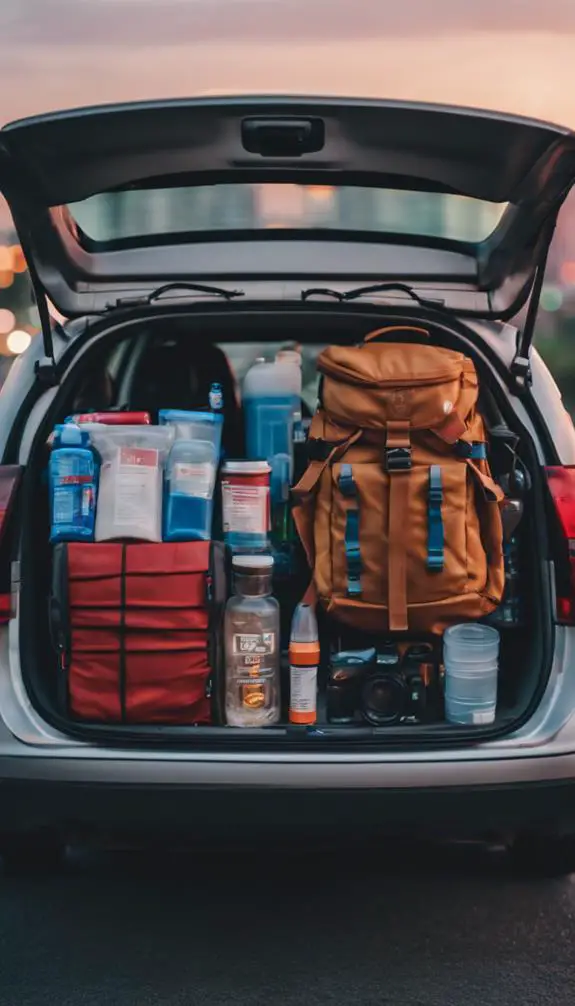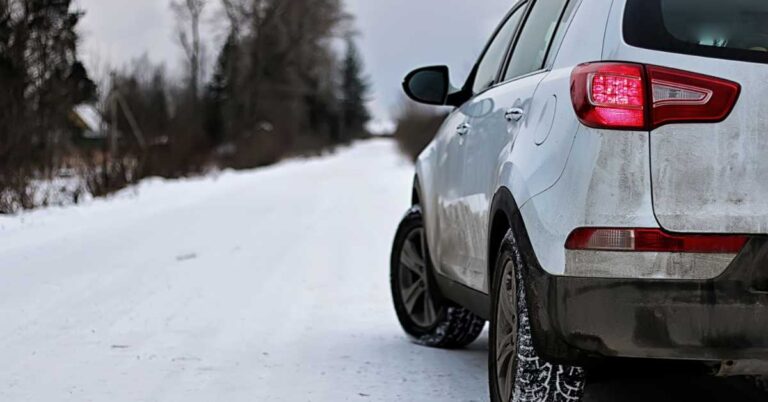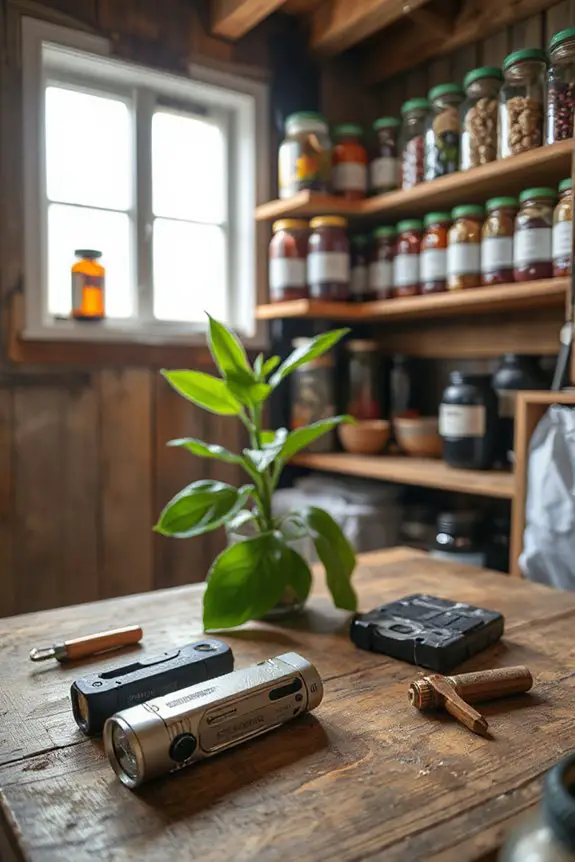When you're on the road, an emergency can strike at any moment. That's why having a bug-out bag specifically designed for your car is vital. You're not just preparing for a minor inconvenience, but for a potentially life-threatening situation. Imagine being stranded in a remote area with no phone signal, no food, and no shelter. What would you do? Having a well-stocked bug-out bag can mean the difference between safety and disaster. But what exactly should you pack, and how can you guarantee you're truly prepared for the unexpected?
Summary
- A bug out bag for a car should include a minimum of 30 liters of storage space to hold essential gear.
- Pack durable, water-resistant materials, such as nylon or polyester, to protect gear from the elements.
- Include a first aid kit, food, water, and communication devices, such as a satellite phone or handheld radio.
- Don't forget clothing and personal gear, like thermal underwear, a fleece jacket, and a waterproof blanket.
- Consider adding a self-defense tool, like pepper spray, and a multi-tool, like a Leatherman, for added safety.
Choosing the Right Backpack
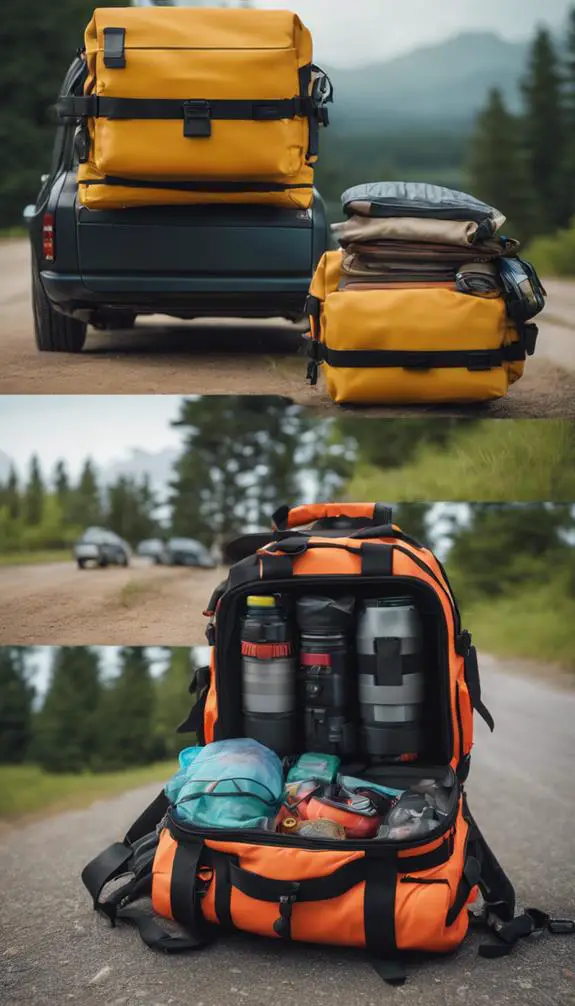
Select a backpack that can withstand the rigors of a bug-out situation by considering factors such as durability, comfort, and capacity.
You'll want a backpack made from durable materials like nylon, polyester, or Cordura that can resist tears and abrasions. Look for comfortable straps with padding and adjustable shoulder straps to guarantee a snug fit.
A backpack with multiple compartments and pockets will help you stay organized and find what you need quickly. Consider a backpack with a capacity of at least 30 liters to store all your essential gear.
Essential Documents to Pack
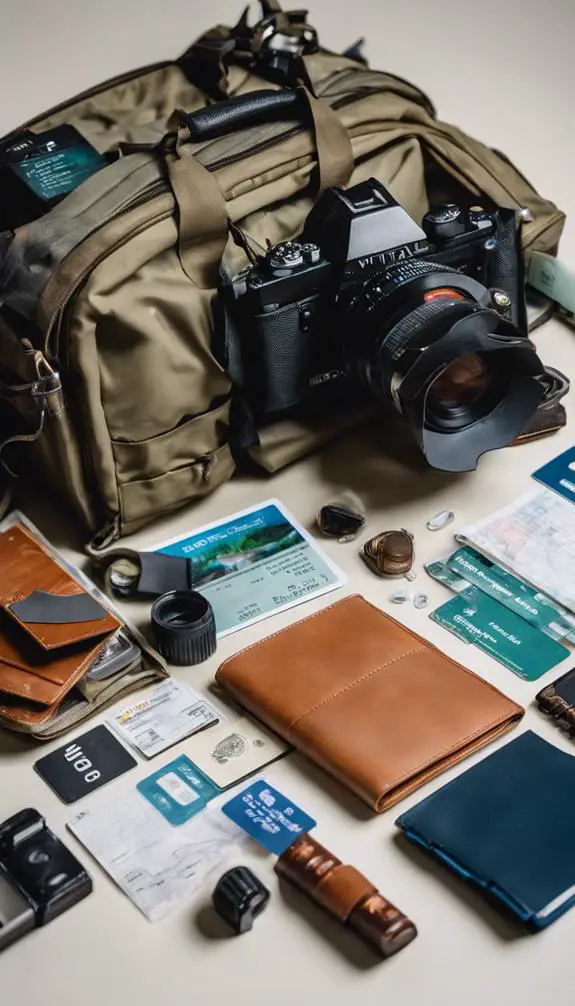
You'll want to pack essential identification papers, such as copies of your driver's license, passport, and birth certificate, in a waterproof bag or pouch to keep them safe and dry.
Don't forget to include important medical records, like prescriptions, allergy lists, and insurance cards, which can be pivotal in an emergency situation.
Vital Identification Papers
When disaster strikes, having quick access to essential identification papers can be a lifesaver.
You should pack key documents that prove your identity, such as a copy of your driver's license, passport, and birth certificate.
Consider scanning these documents and storing them digitally, using secure cloud storage or an encrypted USB drive, for added protection.
This will safeguard you can access them even if the physical copies are lost or destroyed.
Don't forget to include identification for your vehicle, such as the title and registration.
Identity protection is pivotal in emergency situations, so make sure to keep these documents safe and secure.
Important Medical Records
As you assemble your bug-out bag, don't overlook the crucial medical records that can make a significant difference in your care during an emergency.
These records can inform medical professionals about your conditions, allergies, and medications, guaranteeing you receive appropriate treatment.
Pack copies of your medical histories, including chronic conditions, surgeries, and hospitalizations.
Also, include a list of your prescription medications, dosages, and frequencies.
Don't forget to add any relevant test results, such as blood type and lab results.
Having these records readily available can save precious time and potentially save your life.
Make sure to update these documents regularly to guarantee they remain accurate and effective.
Water and Food Supplies
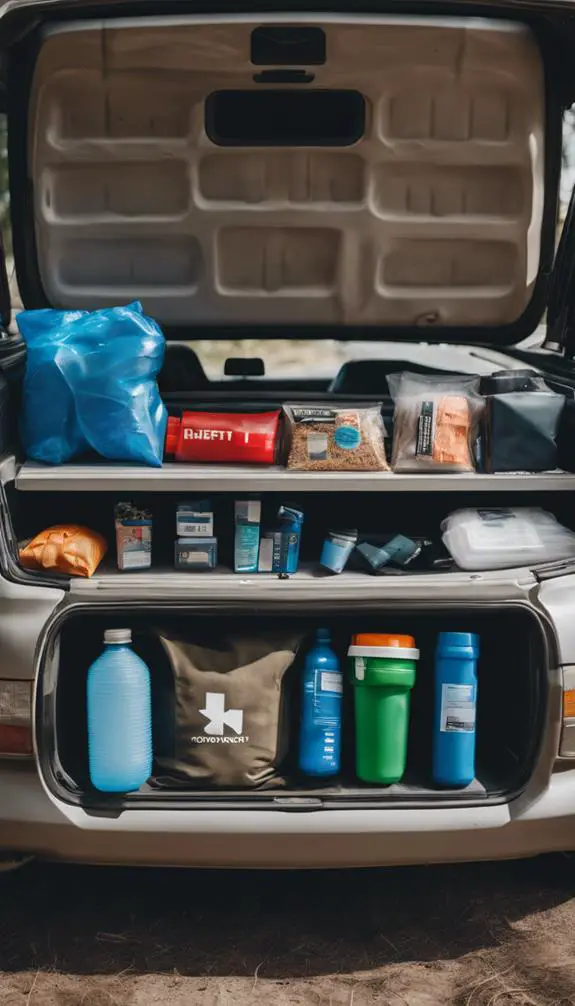
Having a reliable supply of water and non-perishable food is crucial to surviving the initial 72 hours of an emergency situation.
You'll want to store at least one gallon of water per person per day for drinking, cooking, and hygiene. Consider adding a water purifier, like water purification tablets or a portable filter, to guarantee access to safe drinking water.
For food, pack high-calorie, non-perishable items like energy bars, nuts, and dried fruits. Store food rations that are easy to prepare and don't require cooking, such as MREs or dehydrated meals. Don't forget a manual can opener and utensils, like a spork or multi-tool, to make mealtime easier.
First Aid Kit Essentials
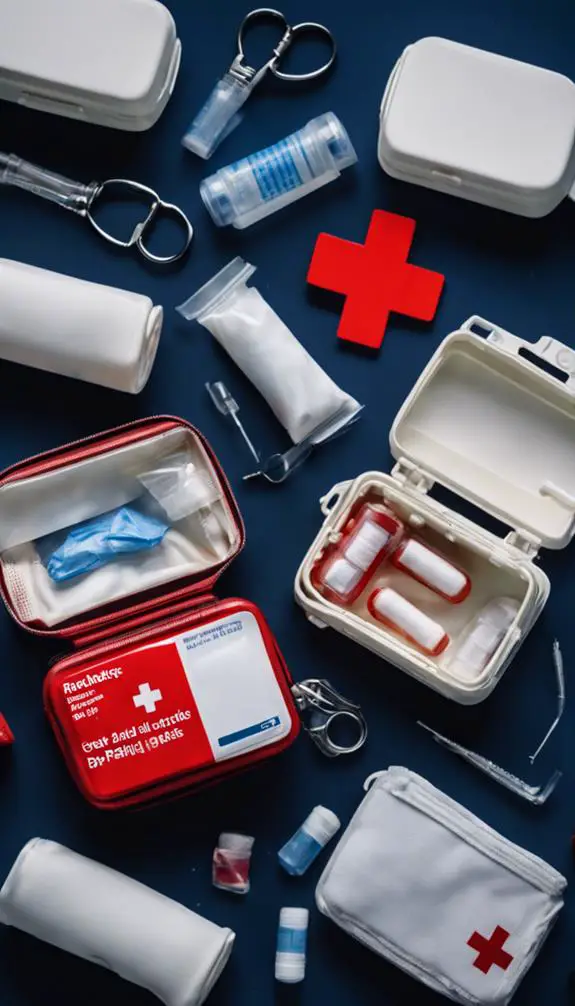
In the aftermath of an emergency, injuries can happen quickly, and a well-stocked first aid kit can be a lifesaver.
You'll want to include basic supplies like bandages, gauze, and antiseptic wipes for wound cleaning. It's also vital to have a plan for medication management, including any prescription medications you or your family members may need.
Don't forget to pack pain relievers, antihistamines, and antibiotic ointments. Consider adding a first aid manual or guide, in case you're not sure how to treat a specific injury.
Remember to check your kit regularly to verify everything is up-to-date and not expired. With a well-stocked first aid kit, you'll be better prepared to handle any medical emergencies that may arise.
Shelter and Warmth Gear
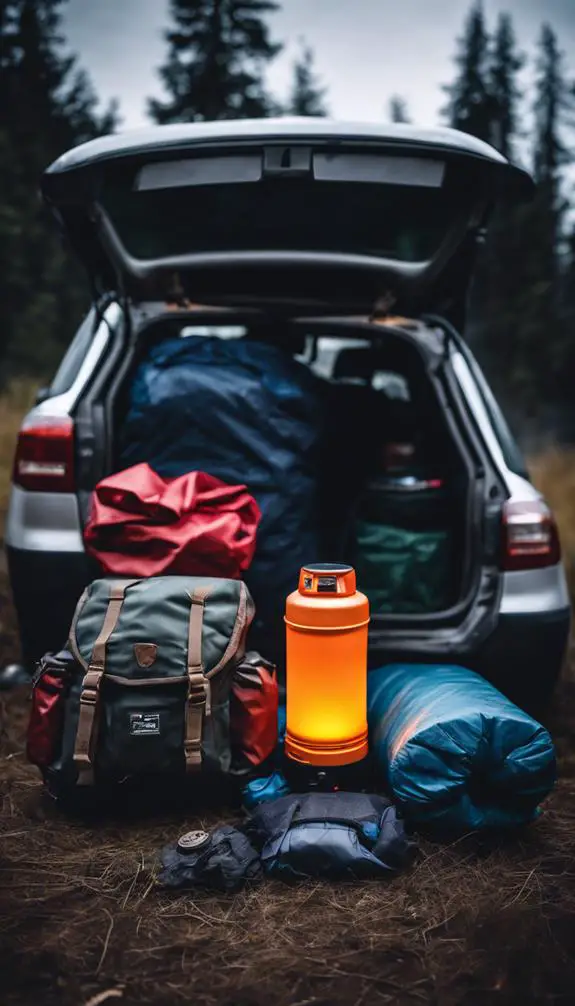
When you're on the move, staying warm and dry is vital, and that's where your emergency blanket and portable shelter come in.
You'll want to choose options that are lightweight, compact, and effective, such as a space blanket or a waterproof bivy sack.
Consider the pros and cons of different emergency blanket options and portable shelter choices to guarantee you're prepared for any situation.
Emergency Blanket Options
At least three emergency blanket options should be included in your bug-out bag to guarantee you have adequate shelter and warmth in a survival situation.
You'll want to weigh Emergency Blanket Choices that cater to different needs and environments.
Look for Lightweight Options that won't take up too much space in your bag. A compact, foil-based emergency blanket is a great choice for its warmth-to-weight ratio.
Another option is a waterproof blanket that can keep you dry in wet conditions.
Additionally, a thermal blanket with a built-in hood can provide extra protection from the elements.
Portable Shelter Choices
You've got your emergency blankets covered, but now it's time to think about more substantial shelter options.
When it comes to portable shelter choices, you've got two main options: tent options and hammock choices.
Tents are a classic choice, providing a waterproof and bug-free space to rest.
Look for lightweight, compact options with a waterproof rating and sturdy poles.
Hammocks, on the other hand, offer a more minimalist approach, providing a comfortable place to sleep while keeping you off the ground.
Consider a hammock with a built-in bug net and rain fly for added protection.
Both options should be easy to set up and take down, making them perfect for your bug out bag.
Communication Devices
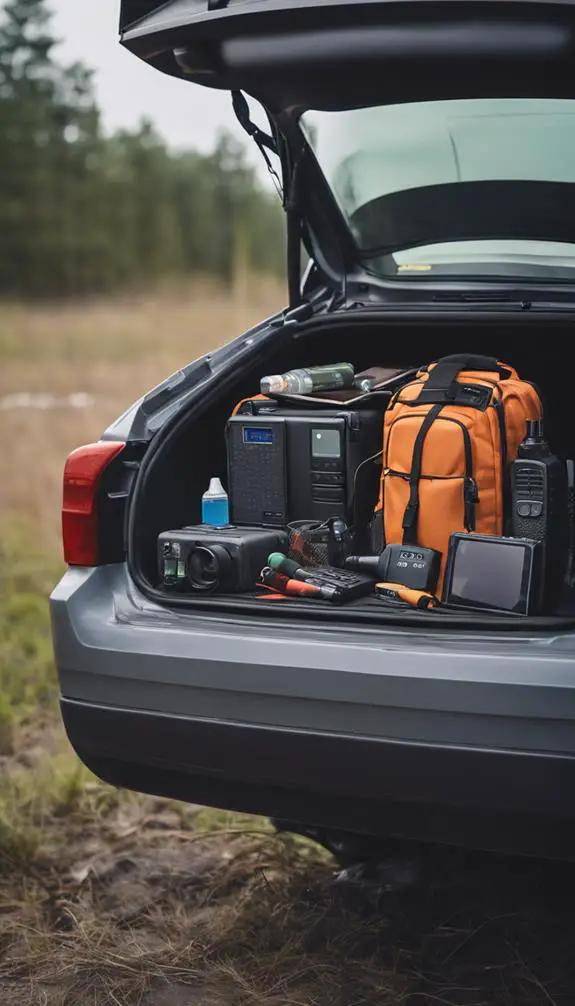
Three crucial minutes can make all the difference in an emergency situation, and having the right communication devices in your bug out bag can be a lifesaver.
You'll want devices that are reliable, durable, and easy to use under pressure. Consider adding a Satellite Phone, like a Garmin inReach or DeLorme, which can send and receive messages even when cell service is down.
Handheld Radios, such as those from Motorola or Yaesu, are also essential for staying in touch with your group or calling for help. Look for models with long battery life, waterproofing, and multiple channels.
Don't forget to pack extra batteries and a charging cable. With these communication devices in your bug out bag, you'll be better equipped to stay connected and get help when you need it most.
Navigation Tools
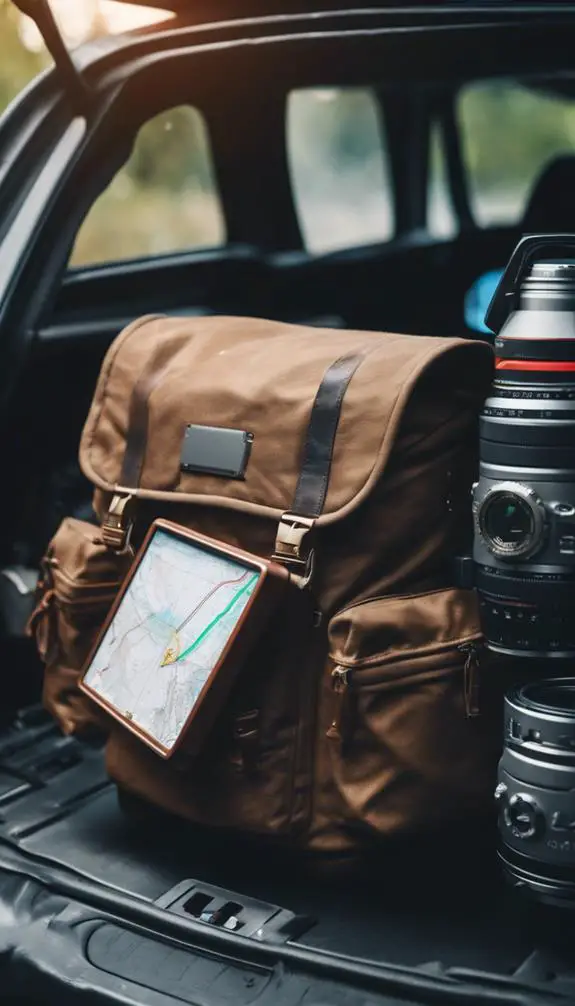
A few essential navigation tools can mean the difference between finding your way to safety and getting lost in the wilderness.
You'll want to include a physical map of your area, as GPS signals can be unreliable in emergency situations. Practice your map skills beforehand to confirm you can read and navigate with it effectively.
A compass is another vital tool – there are several types, including magnetic, gyro, and GPS compasses, each with their own advantages and limitations. Choose one that suits your needs and learn how to use it properly.
Don't rely solely on technology; having a backup plan will give you peace of mind and increase your chances of survival.
Personal Hygiene Items
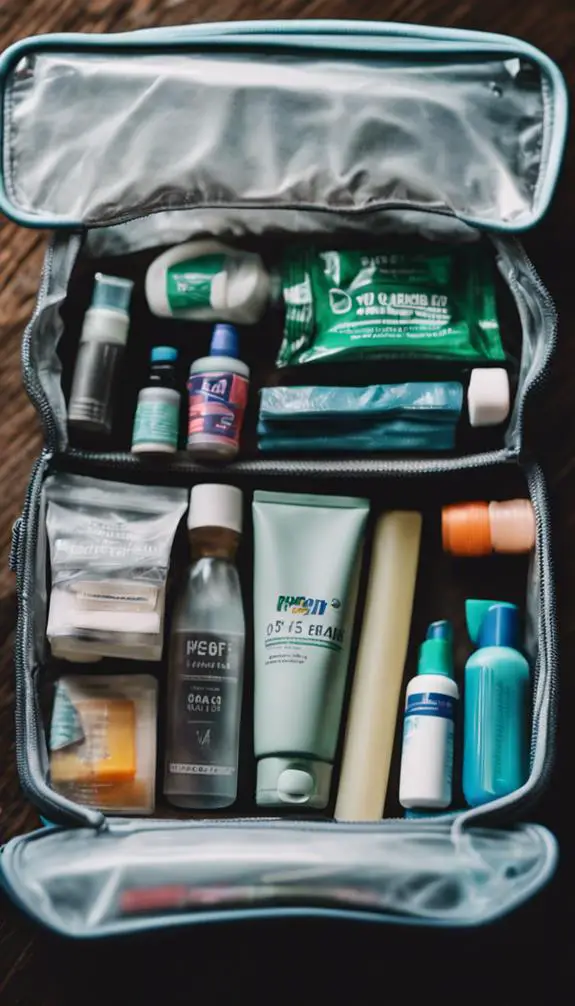
In the aftermath of a disaster, maintaining personal hygiene is crucial for both physical and mental well-being.
You'll want to include essential items in your bug-out bag to keep yourself clean and fresh.
Daily wipes are a must-have for quick cleanups when water is scarce. They're also useful for wiping down surfaces and equipment.
If you're a female, don't forget to pack feminine products, such as sanitary napkins or tampons, to maintain your dignity and health.
Additionally, consider adding hand sanitizer, biodegradable soap, and toilet paper to your bag.
These may seem like small items, but they'll make a big difference in your overall comfort and well-being during a crisis.
Clothing and Footwear
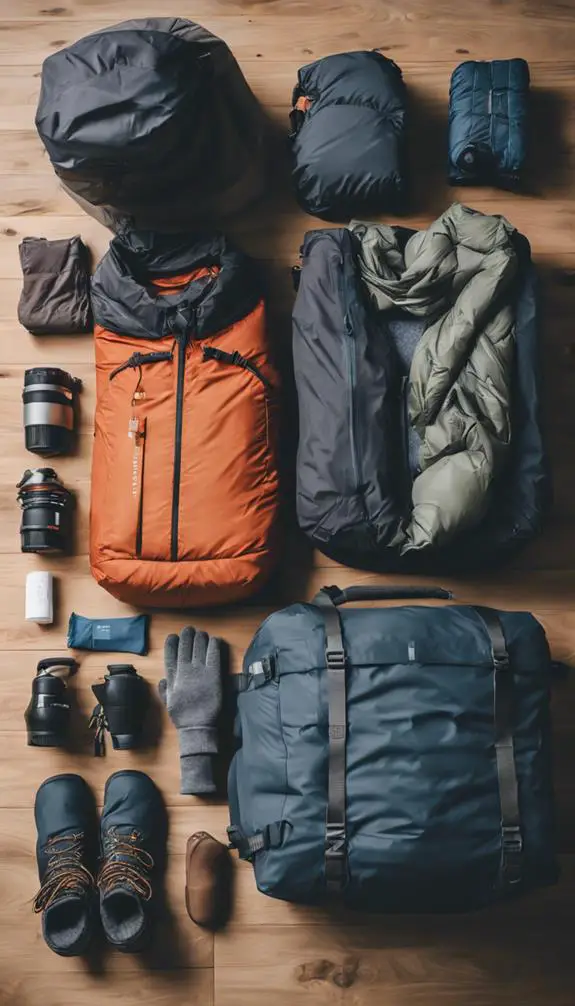
You'll want to pack clothing that can be layered for versatility and adaptability in different environments.
Start with base layers and socks that wick moisture and dry quickly, followed by insulating mid-layers for cold weather.
Base Layers and Socks
Packing the right base layers and socks for your bug-out bag can make a significant difference in your comfort and survival during an emergency situation.
You'll want to prioritize moisture-wicking fabrics that'll keep you dry in cold weather. Look for base layers made from materials like merino wool or synthetic blends that provide excellent thermal regulation.
For socks, choose pairs with moisture-wicking properties and a snug fit to prevent blisters. Consider packing multiple pairs, including some designed specifically for cold weather.
Don't forget to include a spare set of base layers in case the first gets wet. By packing the right base layers and socks, you'll be better equipped to face the challenges of an emergency situation.
Insulating Mid-Layers
The right insulating mid-layers can make a huge difference in your ability to regulate body heat during an emergency situation.
You'll want to pack clothing that provides warmth without restricting movement. Fleece jackets are a great choice as they're lightweight, breathable, and quick-drying. Look for ones with a DWR (durable water repellent) finish to help protect against wind and moisture.
Thermal underwear is another essential item to include. Opt for moisture-wicking fabrics like merino wool or synthetic blends that will help keep you dry and comfortable. Consider packing a pair of thermal leggings or long johns to wear under your pants for added warmth.
These insulating mid-layers will help you maintain a stable body temperature, even in harsh conditions.
Waterproof Outerwear
Protect yourself from the elements with waterproof outerwear that's both durable and reliable.
When you're on the move, you can't let rain or wind slow you down. That's why you need a waterproof outer layer that can keep up with you.
Rain jackets with breathable membranes like Gore-Tex or eVent are great options. They'll keep you dry in even the heaviest downpours.
Windbreakers are also a good choice, providing an extra layer of protection against harsh winds. Look for ones with adjustable cuffs and hem to prevent cold air from seeping in.
When choosing your waterproof outerwear, consider the activity level and climate you'll be in. This will help you select the right level of waterproofing and breathability for your needs.
Self-Defense Options
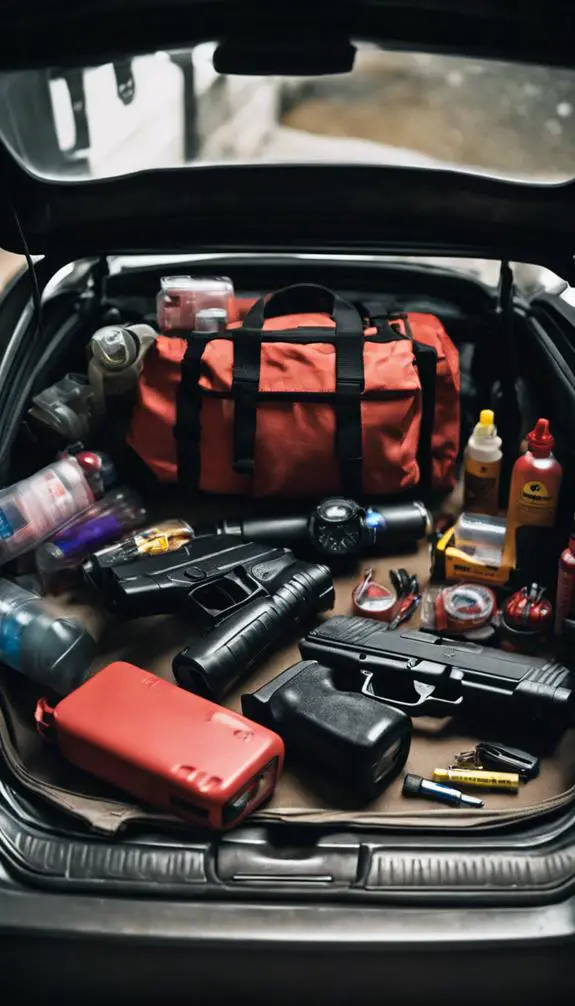
Caught in a survival situation, you'll need to rely on your wits and preparedness to stay safe, and that includes being able to defend yourself.
A bug out bag for your car should include self-defense options to protect you from potential threats. Consider adding pepper spray, a non-lethal yet effective deterrent that can give you time to escape.
A tactical flashlight is another essential item, providing a blinding light that can disorient an attacker and allowing you to create distance. Look for a flashlight with a strobe function, which can further disorient an assailant.
Lighting and Fire Starters
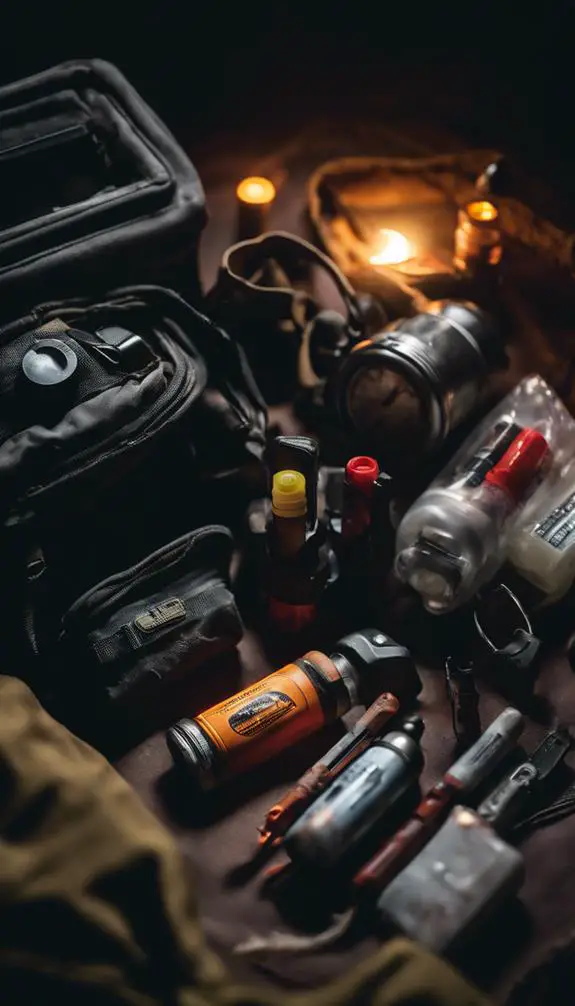
At least three reliable light sources should be included in your bug out bag for your car, as darkness can be a major obstacle in a survival situation.
You'll want a variety of flashlight options, including a handheld flashlight with extra batteries, a headlamp for hands-free use, and a beacon light that can signal for help.
Consider a flashlight with a red light mode to preserve your night vision.
Don't forget waterproof matches or a lighter for starting a fire, which can provide warmth, light, and a way to cook food.
A fire starter kit with tinder and kindling can also be a lifesaver.
Multi-Tool and Duct Tape
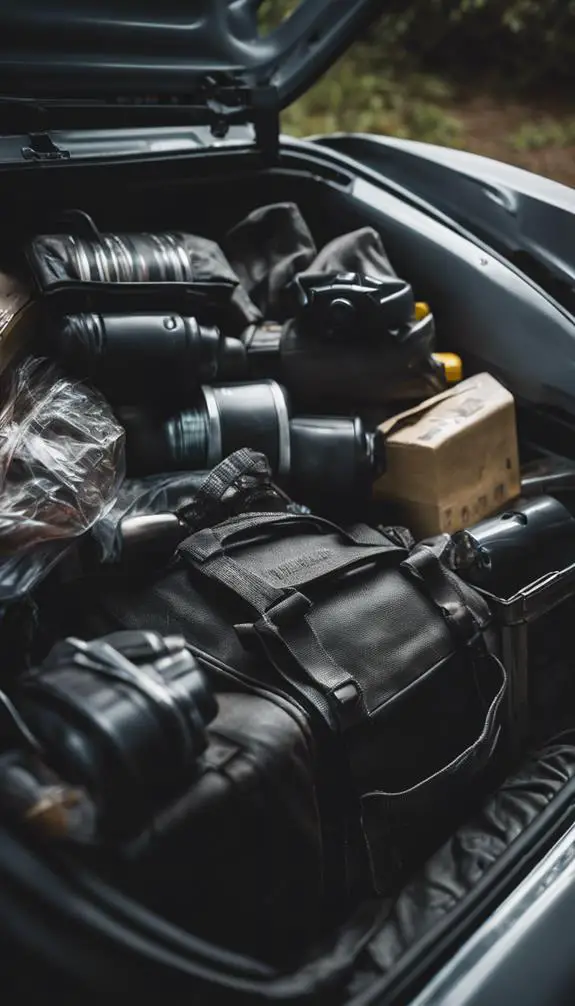
A trusty multi-tool, like a Leatherman, can become your new best friend in a survival situation, providing a compact solution for various tasks.
When selecting a multi-tool, consider the features you need, such as pliers, scissors, and a knife. You'll want something durable and reliable that can withstand rough handling.
Duct tape is another essential item to include in your bug out bag.
This versatile tape can be used for a multitude of tasks, from repairing torn fabric to holding together broken equipment. With a little creativity, you can use duct tape to create a makeshift shelter or even a fishing net.
Vehicle-Specific Emergency Items
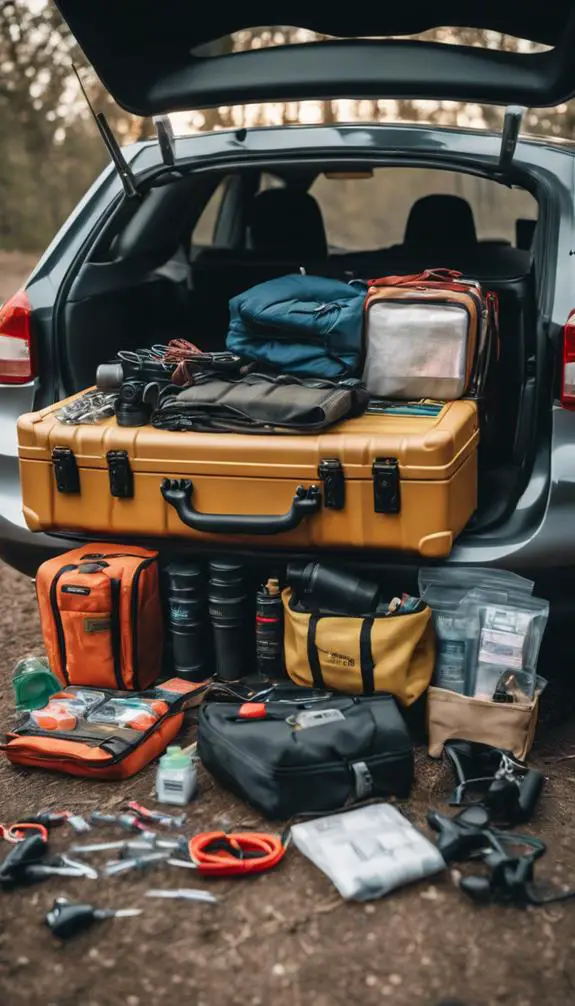
Your vehicle can become a lifeline in a survival situation, providing shelter, transportation, and a means to signal for help.
To guarantee it's ready for an emergency, you'll want to include vehicle-specific items in your bug out bag.
Start with a car charger for your phone and other essential devices.
Add a set of jumper cables, a spare tire, and a tire pressure gauge to verify you can get back on the road quickly.
Don't forget a reflective warning triangle or road flares to signal for help if you're stranded.
Finally, include a car jack and a lug wrench for changing a flat tire.
FAQs
How Often Should I Update and Check My Bug Out Bag?
You should update and check your bug-out bag every 6-12 months to verify kit refreshment, replacing expired items, and restocking essentials to prevent bag expiration, so you're always prepared for the unexpected.
Can I Customize My Bug Out Bag for Specific Emergencies?
You can customize your bug out bag to fit your personal preferences and regional threats, like tailoring it for wildfires, hurricanes, or earthquakes, ensuring you're prepared for the most likely emergencies in your area.
Are Bug Out Bags Only for Extreme Emergency Situations?
You might think bug out bags are only for extreme emergency situations, but they're also for everyday unexpected events; urban dwellers, for instance, can benefit from having a bag ready for sudden evacuations or natural disasters.
How Do I Ensure My Bug Out Bag Remains Compact and Portable?
To keep your bug-out bag compact and portable, you're focusing on weight distribution and a strategic packing approach, ensuring essentials are accessible while minimizing bulk, so you can move swiftly and freely in any situation.
Can I Store My Bug Out Bag in a Hot or Cold Vehicle?
When storing your emergency kit in a vehicle, you'll want to ponder extreme vehicle temperatures, as hot or cold car conditions can damage or ruin your gear, so choose a shaded spot or insulated container to protect your supplies.
Conclusion
You've got a solid bug-out bag for your car, packed with essentials to keep you safe and comfortable in emergency situations. Now, remember to check and update your bag regularly to confirm everything is still usable and not expired. Stay vigilant, and with your bug-out bag by your side, you'll be ready to roll out of trouble and onto safer roads.

